Monday’s planned activity was another tour combing walking, history, culture, and food. The four of us would be taking the “Taste of San Miguel” tour. We chose the Downtown San Miguel Tour, “a guided 3½ hour food and city walking tour featuring seven food tasting locations carefully chosen to highlight the best regional flavors San Miguel has to offer. Tasting unique regional foods is one of the best ways to explore and experience the culture and charm of a city. We have wonderful memories of our Charleston culinary tour last year and so thought this would be a memorable day to share with Sam and Kayda.
We meandered down and through the winding streets to reach El Chorro where we would meet our guide, Eric.
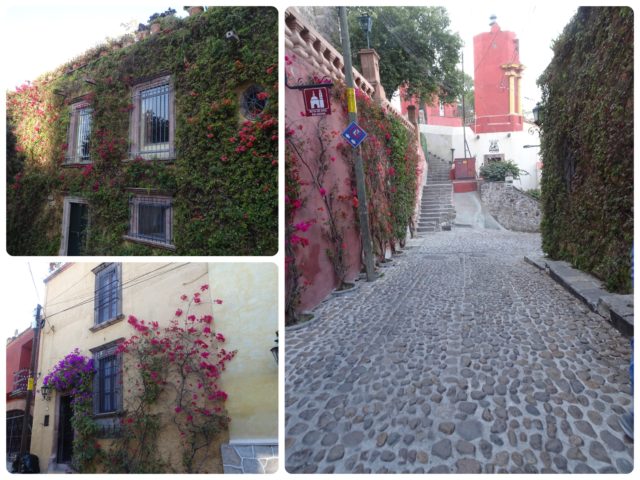

Just past El Chorro is the Casa de la Cultura (House of Culture) promotes dance, visual arts, literature, theater and music workshops taught by specialists from each branch. On one of our strolls by this beautiful building we could hear choral singing filling the air. 🙂
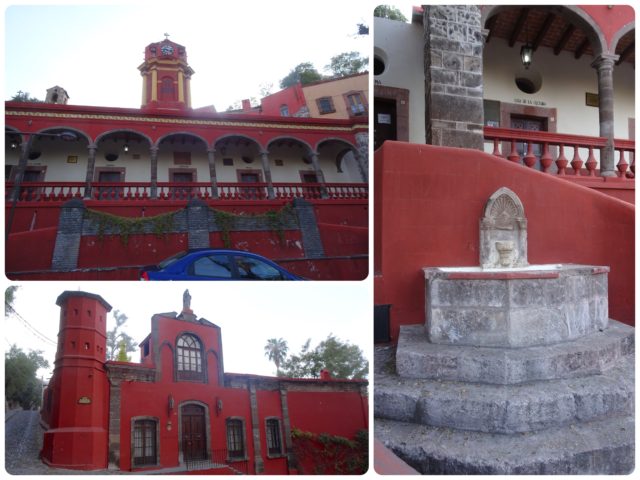
Back in the mid-1550s, Fray Bernardo Cossin moved to higher areas of San Miguel, to a spring that provided fresh water. That place is El Chorro, now this charming little park. This little haven is also called Los Lavaderos meaning laundry or washing place. There are still public washing tubs here that fill from a natural spring.


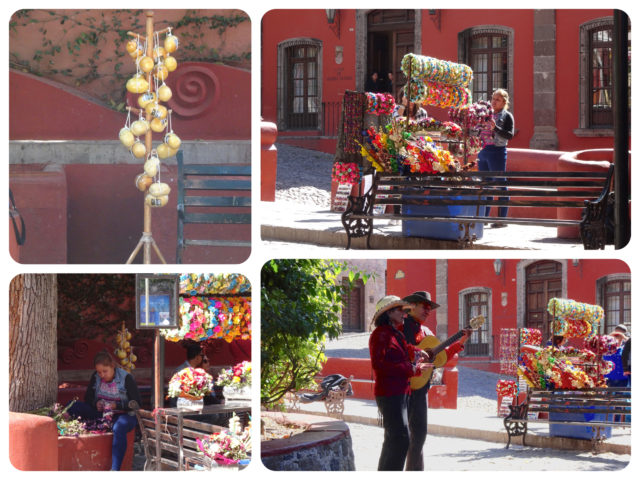
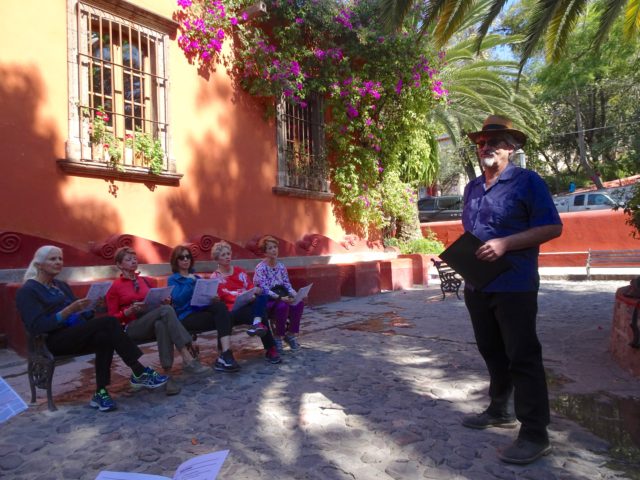
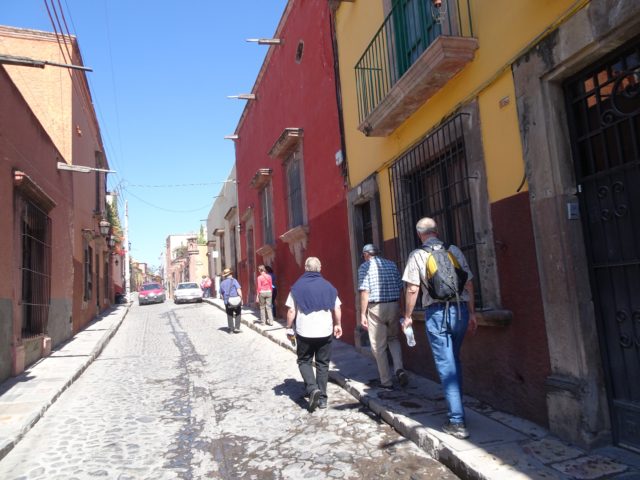
First stop, La Parada, a Peruvian restaurant.


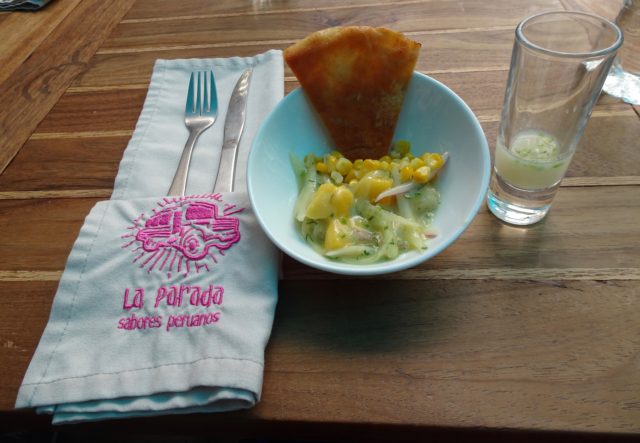
Before reaching our next tasting, Eric took a detour to show us Plaza del Toros Oriente, the “East Bull Ring”. Some sources state that it was built in the 1950s, others say 1856, a discrepancy of 100 years. Hmm?? My thoughts are that there was a bull fighting ring in this location, but that the most recent reincarnation of the structure was in the 1950s. That said, the building looks older than the 1950s to me. The bullfighting tradition of San Miguel has continued since colonial times. In his youth, Ignacio Allende, San Miguel’s favorite son and a horseman of great talent, was a rejoneador, the name given to a bullfighter who fights the bull on horseback.
Although bull fights are still held here, Plaza del Toros is now a venue for weddings, concerts, anniversaries, birthdays, corporate parties and events, expos, and any social gathering.
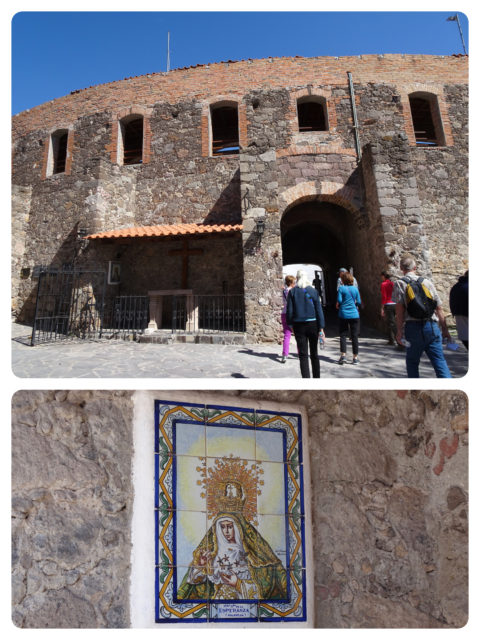


Back to the food!! That’s why we are here, walking about, right? Next stop was Casa del Diezmo.

Casa del Diezmo, dates back to the colonial era when it housed the administrative offices of the Catholic Church and the wineries for tithing. Under Spanish rule, before Mexican independence, citizens were required to give the church 10% of their income, which was often paid in kind with crops, livestock and in central Mexico, with silver. These funds supported the maintenance of the clergy and churches of San Miguel. Diezmo = tithe and diez = ten. The restaurant remains connected to its roots by keeping the name.
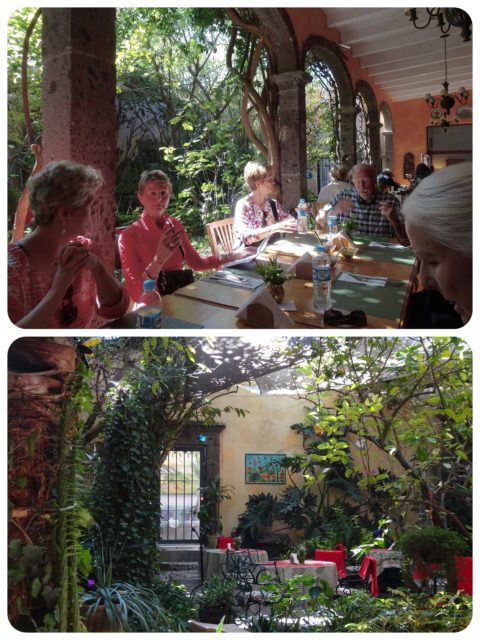
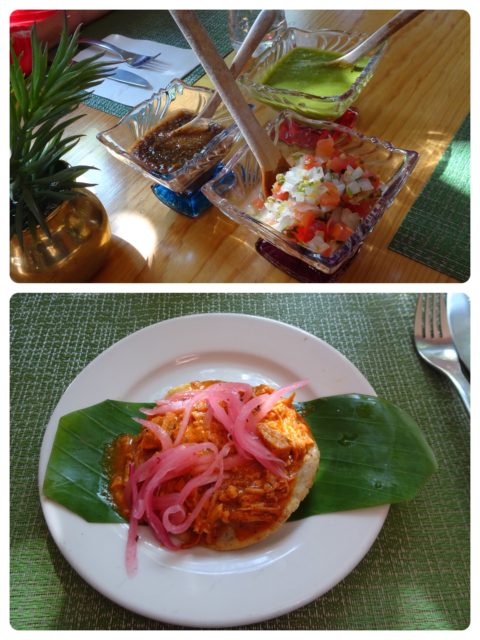
The third stop on our tasting tour was once again behind a very ordinary looking doorway in a wall, La Cocina, Café del Viajero, which translates to “the kitchen, café for the traveler”. It is most commonly known as “the kitchen.”

Like many of the restaurants we have seen, the entrance opens into an interior space that is really “interior” as in floor, ceiling and walls. Then one steps through into a courtyard, semi-outdoor space with light and plants.


I’ve always wanted to try a mole sauce, although I really didn’t know what the ingredients are. I learned that mole is a generic term for a variety of Mexican sauces Traditional moles are labor intensive from the grinding of the ingredients, which usually include fruit, chili pepper and nuts. It was with great anticipation that I tasted La Cocina’s “Oaxacan Black Mole”. This mole recipe’s ingredients included cacao, 5 different chilis, pumpkin seeds, bananas, apples. The mole topped an emmolada (corn tortilla with shredded chicken.) I have to be honest – I was disappointed. Expectations too high? It just didn’t appeal to my taste buds.
Los Milagros (miracles), our fourth restaurant, was also hiding behind a doorway. It is said to be a ” local institution” that serves some of the best molcajetes and tortilla soup in town.
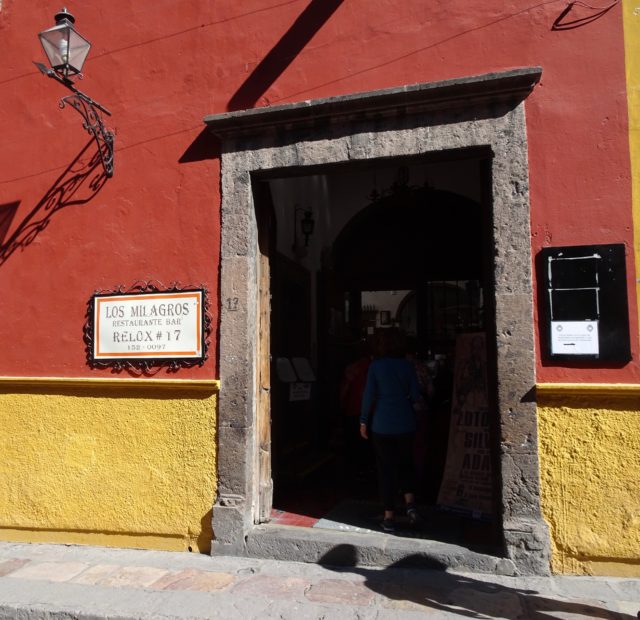
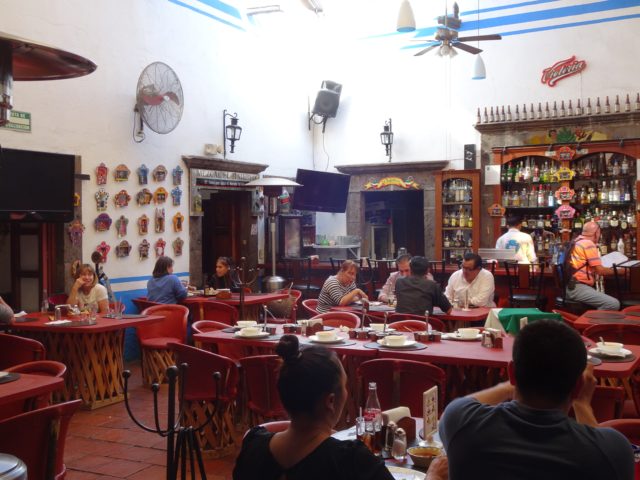

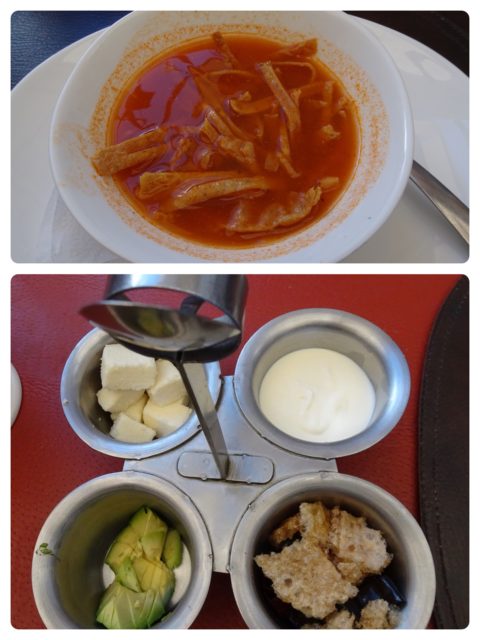
Stop #5 was not a restaurant, but a street vendor. Nieves Las Monjas is one of the oldest and busiest food stands in San Miguel. Nieves Las Monjas has been serving homemade Mexican ice cream for 40 years. With no electricity, the ice cream is kept cold using the old-fashioned, low tech method of salt and ice. Nieve means “snow” and Las Monjas means “the nuns.” I get the snow part for ice cream, but nuns???
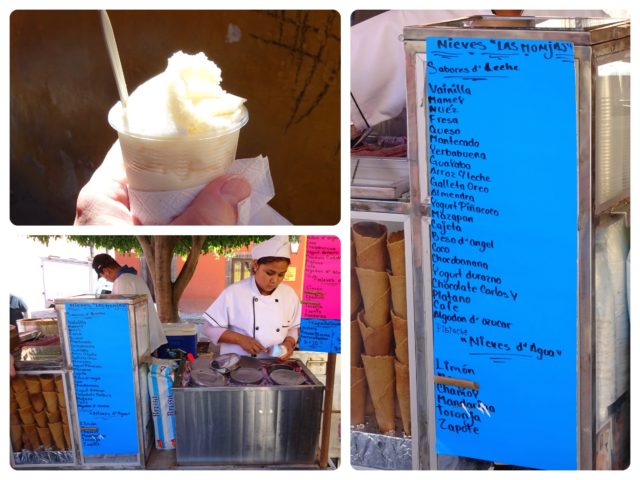
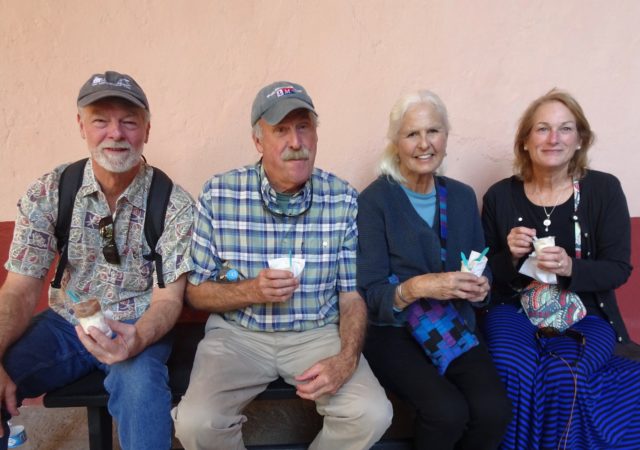
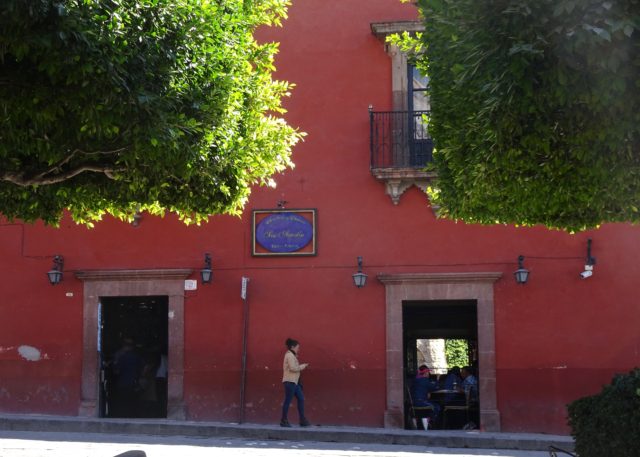
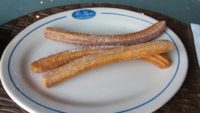
The tour had taken a decidedly sweeter turn by now. After the ice cream, the next place was San Agustín Churros y Cholocate, a San Miguel landmark. Unfortunately, it was too crowded for the ten of us to enter. Eric brought the churros out to us in the park across the street. Churros are a fried-dough pastry, sprinkled with sugar, and often dipped in chocolate.

The final stop was more unusual than any of the others. El Gato Negro, the second-oldest bar in San Miguel de Allende, is a tiny hole-in-the-wall cantina, dating back to 1921. The original owner had a business delivering fuel, and a black cat was its mascot. The business changed (a different kind of fueling?) but the black cat theme stayed.

We were here to taste tequila, served in these sweet itty-bitty pottery “mugs.”


For 50 years, El Gato Negro was a men only dive. Here’s the proof in pictures —

I hate to end the tour’s description on that note, but that is where the tour ended. Haha. We all had a great time on our “Taste of San Miguel” adventure and would enthusiastically recommend it. It was fun, it was yummy, it was outside on a beautiful day, and indoors in lovely settings (mostly). We thoroughly and literally enjoyed a taste of Mexican culture. What more could you want?
On second thought, there is a better way to end this “Taste of San Miguel” blog post! Sam introduced us to two Mexican beers (not Corona or Dos XX).
Modelo Negra quickly became our favorite. As Brian’s Belly describes it —“A complex beer, redolent with caramel and chocolate flavors from the malt, the beer is perfectly balanced with a bit of spiciness or nuttiness in the hop aspects of its flavor profile.” Our new favorite cerveza. We shall try to find it in New England!

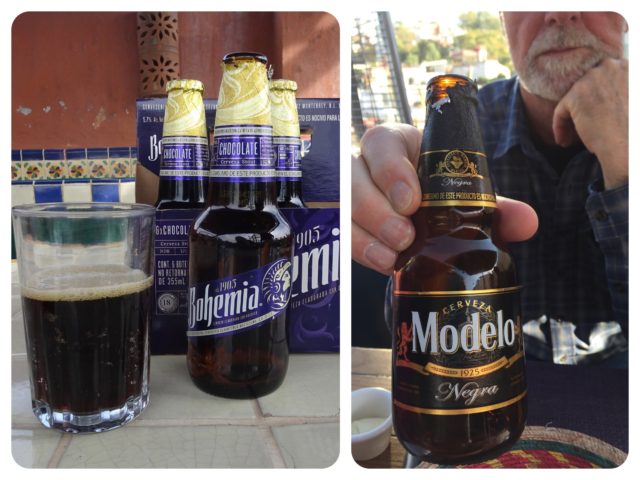
Leave a Reply